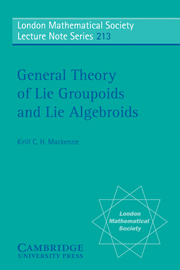Book contents
- Frontmatter
- Contents
- Prologue
- Introduction
- Preface
- TERMINOLOGY AND NOTATION
- ACKNOWLEDGEMENTS
- PART ONE THE GENERAL THEORY
- 1 Lie Groupoids: Fundamental Theory
- 2 Lie Groupoids: Algebraic Constructions
- 3 Lie Algebroids: Fundamental Theory
- 4 Lie Algebroids: Algebraic Constructions
- PART TWO THE TRANSITIVE THEORY
- PART THREE THE POISSON AND SYMPLECTIC THEORIES
- Appendix
- Bibliography
- Index
1 - Lie Groupoids: Fundamental Theory
from PART ONE - THE GENERAL THEORY
Published online by Cambridge University Press: 05 April 2013
- Frontmatter
- Contents
- Prologue
- Introduction
- Preface
- TERMINOLOGY AND NOTATION
- ACKNOWLEDGEMENTS
- PART ONE THE GENERAL THEORY
- 1 Lie Groupoids: Fundamental Theory
- 2 Lie Groupoids: Algebraic Constructions
- 3 Lie Algebroids: Fundamental Theory
- 4 Lie Algebroids: Algebraic Constructions
- PART TWO THE TRANSITIVE THEORY
- PART THREE THE POISSON AND SYMPLECTIC THEORIES
- Appendix
- Bibliography
- Index
Summary
The first two sections of this chapter are concerned with the most basic definitions and examples. In §1.3 we describe the class of locally trivial Lie groupoids: those Lie groupoids which are — subject to an important proviso — equivalent to principal bundles. In a sense which will be clear after §1.5, locally trivial groupoids are the simplest interesting class of Lie groupoids.
In §1.4 we deal with the basic properties of bisections; these may be thought of as ‘generalized elements’ of a groupoid. In Theorem 1.4.14 we give the important description, due to Xu, of the tangent groupoid structure in terms of bisections.
The first part of §1.5 extends to Lie groupoids the elementary properties of the identity component of a Lie group. We then consider the partition of the base manifold of a Lie groupoid by transitivity components, or orbits, and prove the fundamental result of Pradines that the restriction of a Lie groupoid to an orbit is locally trivial.
The final two sections deal with actions of Lie groupoids on general maps and in particular with linear representations on vector bundles. For groupoids there is a diagrammatic characterization of actions in terms of the notion of action groupoid and action morphism. This is a feature of groupoid theory not available for groups. Whereas a group action can be described diagrammatically only by using the action map G × M′ → M′, which is not a morphism, or the associated G → Diff(M′), which can raise problems of differentiability, a Lie groupoid action can be described in terms of a single morphism of Lie groupoids.
- Type
- Chapter
- Information
- General Theory of Lie Groupoids and Lie Algebroids , pp. 3 - 52Publisher: Cambridge University PressPrint publication year: 2005



